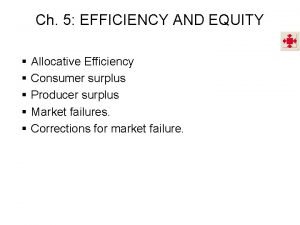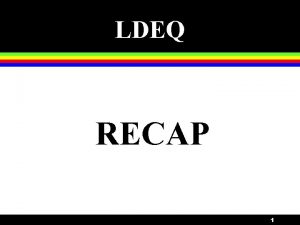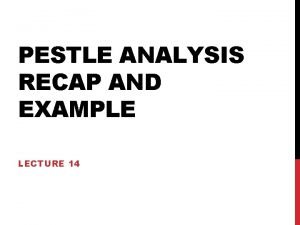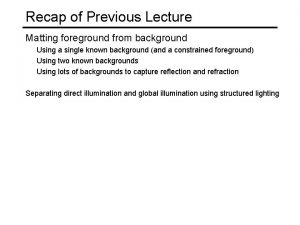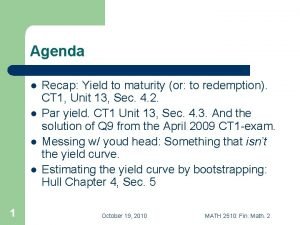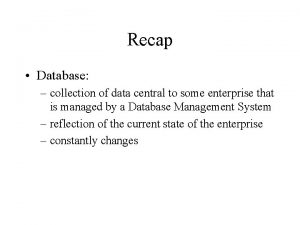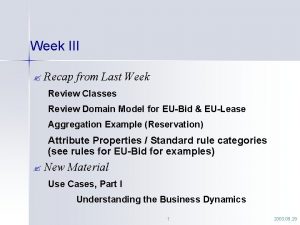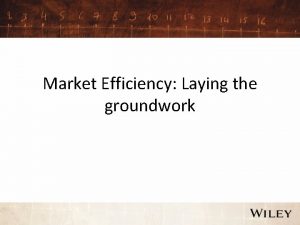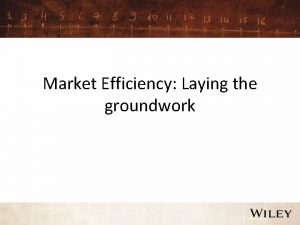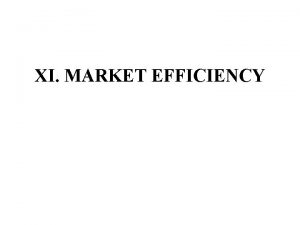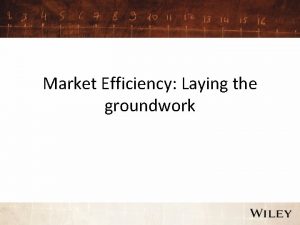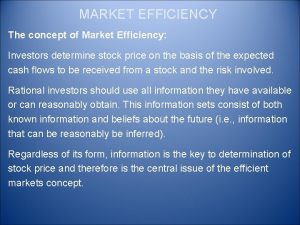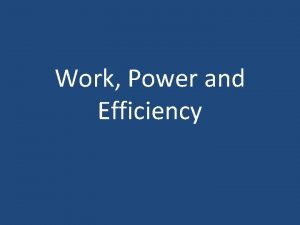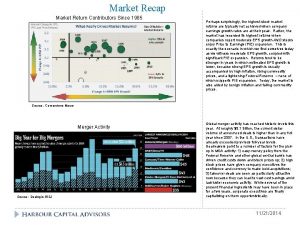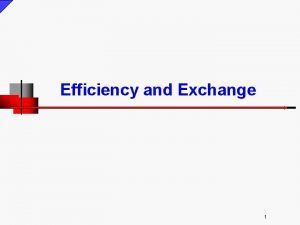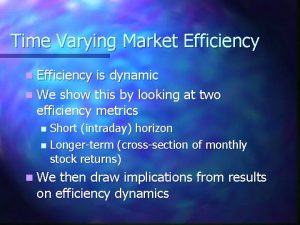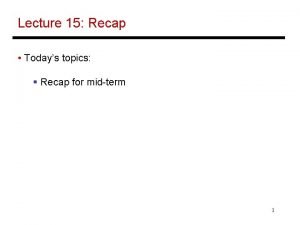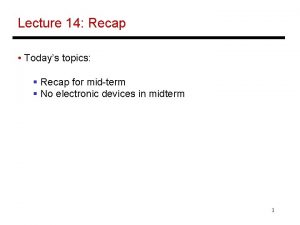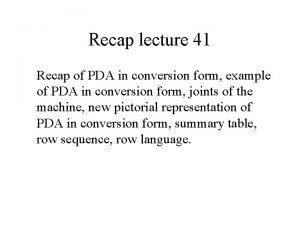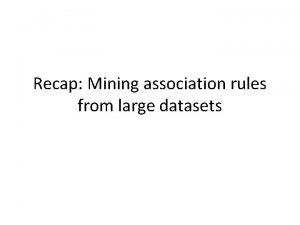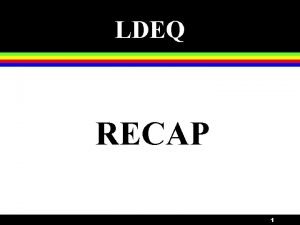Market Efficiency A Recap n Market efficiency occurs




























- Slides: 28

Market Efficiency: A Recap n Market efficiency occurs when individuals know the true opportunity cost of their actions. n The “invisible hand” of the marketplace helps to maximize total benefits to society. . . but market failures can still happen.

Market Failure n Market failure: an example No government regulation against pollution n A town with clean air n A steel mill opens and emits smoke that causes: n § more respiratory diseases § dirtier clothes, houses, cars, etc.

Market Failure n Market failure: an example Steel mill doesn’t pay for clean air n Costs of production have “spilled over” to the residents (third parties) n Lower production cost n More steel is produced than would otherwise be the case

Market Failure n When a market outcome affects parties other than the buyers and sellers in the market, side -effects are created called externalities. Externalities: the impact of one person’s actions on the well-being of a bystander. n Externalities cause markets to be inefficient, and thus fail.

Negative Externalities n The uncompensated costs that are imposed upon individuals who are not directly involved in the production or consumption of goods. äThe act of producing or consuming goods sometimes generates costs to those who are not paid for them. n Automobile exhaust n Cigarette smoking

Positive Externalities n The uncompensated benefits that are received by individuals who are not directly involved in the production or consumption of goods. äThe act of producing or consuming goods sometimes generates benefits to those who do not have to pay for them. n Immunizations n Restored historic buildings

External Costs Panel (a) Price of Steel per Ton S 2 S 1 E 1 P 2 P 1 A E D Q 2 Q 1 Quantity of Steel per Year

Negative Externalities in Production o A negative externality like pollution results in a new supply curve. äThe cost to society is larger than the cost to the producer. äThe social cost includes the private costs plus the costs to those bystanders adversely affected by the pollution.

Negative Externalities in Production o The intersection of the demand curve and the social-cost curve determines the optimal output level. äThat optimal output level is less than the equilibrium quantity.

Attainment of the Optimal Output o Internalizing an externality involves altering incentives so that people take into account the external effects of their actions.

Attainment of the Optimal Output o The government can internalize an externality by imposing a tax on the producer to reduce the equilibrium quantity to the socially desirable quantity.

External Benefits Panel (b) Price of Inoculation S P 2 P 1 D 2 D 1 Q 2 Quantity of Inoculations per Year

Externalities and Market Inefficiency o Positive externalities in production or consumption lead to market failure. äThe market produces a smaller quantity than is socially desirable. äThe social costs of production are less than the private cost to producers and consumers.

Positive Externalities in Production o The intersection of the demand curve and the social-cost curve determines the optimal output level. äThat optimal output level is more than the equilibrium quantity.

Attainment of the Optimal Output o The government can internalize the externality by subsidizing production—paying the producer to produce more than the equilibrium quantity so that the socially desirable quantity is met.

Government Policy Toward Externalities - Summary o The government may attempt to internalize the externalities by. . . imposing a tax on goods with negative externalities. . subsidizing goods with positive externalities.

Market for Pollution Rights Advantages Real-world examples Price Per Pollution Right P S=Supply of Pollution Rights D 2018 $200 D 2008 $100 0 500 750 1000 Quantity of 1 -Ton Pollution Rights Q

Optimal Externality Reduction How much pollution abatement? MC = MB Society’s Marginal Benefit and Marginal Cost of Pollution Abatement (Dollars) MC Socially Optimal Amount Of Pollution Abatement MB 0 Q 1

Lojack: A Case of Positive Externalities o o o Crime reduction expenditures $300 billion Lojack car recoveries 95% vs. 60% External benefits n n o Catch thieves Locate and stop chop shops MSB 15 times the MC n n Underallocation Policy to encourage use of Lojack?

Informed Decision Making Asymmetric Information A business may have better knowledge of its own current and future prospects than do potential lenders. Moral Hazard Adverse Selection

Informed Decision Making Moral Hazard Assuming additional risk when risk taker knows they won’t have to incur full consequence. (hidden action) Adverse Selection The potential for those who wish to borrow funds to use in unworthy projects. (hidden information)

Market Based Approach Tragedy of the commons Resource lacks defined ownership Air, lakes, etc. No incentive to maintain Market for externality rights Right to pollute Can be bought and sold

Review: Information Failures Asymmetric information Inadequate buyer information Gasoline market Licensing of surgeons Inadequate seller information Moral hazard problem Adverse selection problem Workplace safety Qualification

Key Terms private goods public goods free-rider problem cost-benefit analysis marginal-cost-marginalbenefit rule externalities Coase theorem tragedy of the commons market for externality rights optimum reduction of an externality cap-and-trade program climate-change problem asymmetric information moral hazard problem adverse selection problem

Conclusion Uncompensated effects that the production or consumption of goods have on third parties are called externalities.

Conclusion Negative externalities result in a market equilibrium beyond the social optimum.

Conclusion Positive externalities result in a market equilibrium short of social optimum.

Conclusion Solutions to externalities can be accomplished through private agreements or government intervention.
 Allocative efficiency occurs when
Allocative efficiency occurs when Allocative efficiency and productive efficiency
Allocative efficiency and productive efficiency Productively efficient vs allocatively efficient
Productively efficient vs allocatively efficient Productive inefficiency and allocative inefficiency
Productive inefficiency and allocative inefficiency Briefly recap
Briefly recap Ldeq recap
Ldeq recap Recap intensity clipping
Recap intensity clipping Example of recap
Example of recap Fractions recap
Fractions recap Recap background
Recap background Introduction for recap
Introduction for recap Let's have a quick recap
Let's have a quick recap Chapter 8 great gatsby analysis
Chapter 8 great gatsby analysis Logbook recap example
Logbook recap example Romeo and juliet act 1 summary
Romeo and juliet act 1 summary 60 minutes recap
60 minutes recap Let's recap
Let's recap Recap
Recap Recap introduction
Recap introduction Non cognitivism
Non cognitivism Price matching
Price matching Recap poster
Recap poster Ytm recap
Ytm recap Recap accounting
Recap accounting Recap database
Recap database Let's recap
Let's recap Y axis on a graph
Y axis on a graph The crucible act one questions
The crucible act one questions Recap from last week
Recap from last week
